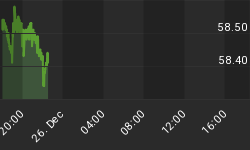Most market participants use investor sentiment as a contrary tool. Gauge which direction the majority of investors are leaning and bet against them. But there are times when it doesn't pay to bet against the herd. There are times when too many bulls is a good thing as in "it takes bulls to make a bull market". So here we have the SP500 closing above the much watched 40 week moving average, and I am sure many an investor is trying to gauge the significance of such a milestone in this seasonally positive time of year when trading volumes have shrunk. So this technical event must mean something?
Yes, it means that the SP500 has now been above the 40 week moving average only twice in the past 20 weeks. Does it mean that the market is on the cusp of an explosive move higher? If the market is, don't tell investors because they haven't gotten the message yet. And that is really the trouble with this market - there are neither bears or bulls out there. If the market is really going to move higher in a meaningful way, I would think that we would begin to see the "it takes bulls to make a bull market" scenario (i.e, too many bulls) unfold as prices move higher. This is how new trends start, but instead we are just seeing ehhh.
So if this price move is for real and if the pending recession (see here) is going to be thwarted, then I would expect to see buyers. Sentiment cuts both ways sometimes; having a lot of bulls could be a good thing. For now, I remain bearish, and I gave my reasons nearly 4 weeks ago. Despite the passing of time and the expected holiday rally, little has happened to change that opinion.
The "Dumb Money" indicator (see figure 1) looks for extremes in the data from 4 different groups of investors who historically have been wrong on the market: 1) Investors Intelligence; 2) MarketVane; 3) American Association of Individual Investors; and 4) the put call ratio. This indicator shows neutral sentiment.
Figure 1. "Dumb Money"/ weekly
Figure 2 is a weekly chart of the SP500 with the InsiderScore "entire market" value in the lower panel. From the InsiderScore weekly report: "As of 12/21/11 - Sentiment moved from a Sell Bias to Neutral as buyers outnumbered sellers - albeit by the slimmest of margins - for the first time in three weeks. The main sentiment driver was a decrease in selling, as the number of sellers fell nearly -23% week-over-week versus a 7% increase in the number of buyers. The Consumer Discretionary and Energy sectors showed the greatest improvement in sentiment, with a drop in selling again being the main cause. There continues to be a fair amount of actionable buying and actionable selling and with no sector showing a particularly strong signal in either direction we find company-level activity most compelling."
Figure 2. InsiderScore "Entire Market" value/ weekly
Figure 3 is a weekly chart of the SP500. The indicator in the lower panel measures all the assets in the Rydex bullish oriented equity funds divided by the sum of assets in the bullish oriented equity funds plus the assets in the bearish oriented equity funds. When the indicator is green, the value is low and there is fear in the market; this is where market bottoms are forged. When the indicator is red, there is complacency in the market. There are too many bulls and this is when market advances stall. Currently, the value of the indicator is 58.72%. Values less than 50% are associated with market bottoms. Values greater than 58% are associated with market tops.
Figure 3. Rydex Total Bull v. Total Bear/ weekly
TheTechnicalTake offers a FREE e-newsletter: HERE















